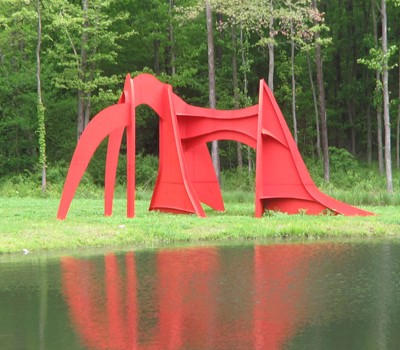Alexander Calder
Rijksmuseum, Amsterdam, June 21st to October 5th
Alexander Calder (1898-1976) trained as an engineer, and it shows. As a boy he made eccentric toys and animals, displaying skill and craftsmanship from the off. In 1930, after visiting Mondrian’s studio in Paris, he tried a new kind of sculpture—an intricate, scientific procedure, relying on balance and counter-balance. “I wish I had thought of that,” said Einstein.
Calder’s sculptures fall into two categories. First, the mobiles, as Duchamp called them: flat, abstract shapes attached to skinny wire rods that jut out at irregular angles, they speak a language of their own. A gust of wind sends them into a frenzy; a gentle breeze lets them dance. They are owned by the space they inhabit, which means that they mimic life.
If the mobiles are butterflies, the stabiles are elephants. Made of huge sheets of metal, they soar into the air with great force. “Tripes” (1974), is a towering biomorphic mass with tentacles curling everywhere. “Caliban” (1964), is a powerful creature—half scary, half comical. But the stabiles remain light and dynamic, the work of a man with a careful, technical touch.
Calder’s late works are among the few truly successful examples of urban art, so they sit comfortably in city centres. Their next gig is in the stunning gardens of the Rijksmuseum, where 20 vibrant works will join the deckchairs and coffee kiosks. Einstein would have loved it.
Image “Jerusalem Stabile”, 1976 (Calder Foundation / Art Resource)


Comments are closed.